What is Beehiiv and How Does It Compare to WordPress?

If you're looking to start a blog online, there are a lot of different ways you can do it. WordPress is one of the biggest, of course, and even has the option of the hosted WordPress.com or the self-managed WordPress.org versions.
Beyond WordPress, though, there are other platforms for blogging you can try. Some are similar to WordPress.com, where you can set up your own blog on their domain for free. Sites like Blogger, Medium, and Substack all offer this basic blogging functionality. The trade-off is in the details; you lose custom branding from your domain, you often can't directly make money with them, and there are very limited options for site design.
Another option, one that is relatively new to the world but is making waves, is Beehiiv. In fact, a surprising number of bloggers are switching from WordPress to Beehiiv. Are they jumping the gun on a short-lived trend or getting in early on something great? Let's talk about how the two compare.
What is Beehiiv?
Since there's a pretty good chance you already know what WordPress is, let's dive right into what Beehiiv is.
Beehiiv was founded in 2021 as another entry in the blogging and newsletter space. It's ostensibly primarily a newsletter platform, but that belies the way it functions.
When you think about a newsletter, you probably think about an email newsletter, right? But platforms like Substack are also, technically speaking, newsletter platforms. The newsletter is emailed out, but it's also there in web form for people to read. So, really, it's a whole lot like a blog, right?
A lot of people seem to want some form of evolution in the newsletter space, so much so that platforms like Substack are taking off, and Beehiiv is riding that wave. Their most recent bit of news is even that they received $12.5 million in seed funding from venture capital in a Series A round.

What is Beehiiv in practice? It's sort of like three services stapled together and smoothed over to be seamless:
- A website builder for creating newsletter content.
- A CMS for managing newsletter content as blog posts.
- Email management software to handle the subscriber and communication side.
A big part of Beehiiv is the ability to monetize your content, similar to Substack. It's not just through paid subscribers, though; it also allows you to integrate and run display ads through the Beehiiv ad network.
How much does Beehiiv cost?
Beehiiv has three tiers of plans, with a fourth option once you grow beyond the bounds of the normal high-tier plan.

First up is the Launch plan, which is designed for people who are just getting started and want to launch a newsletter/blog. It's completely free and gives you the custom website and newsletters through the website builder. You get their built-in analytics, unlimited email sends, and up to three publications. There are even some advanced features, like being part of the recommendation network, getting optimized delivery, subscriber tagging, audience segmentation, and API access. You do also get a custom domain, as well.
By three "publications," what they mean is three individual newsletters or email campaigns. It's basically like having three blogs as part of your site. WordPress requires Multisite for this.
The Launch plan also has one more limitation: you can only have up to 2,500 subscribers to your newsletter.
The middle-tier plan is the Scale plan and is everything in the Launch plan, plus more. You get access to the ad network and the boost network, you can implement paid subscriptions, you can run email automations, run a referral program, and send out surveys. You also get "3D analytics" (which is just their word for more detailed analytics), as well as their AI system. You can run a team of up to three people, and you can access webhooks as well. This is also the first tier where you get access to company support and the community Slack.
The Scale plan starts at $43 per month for up to 1,000 subscribers. For 2,500 subscribers (the same as the Launch plan), it's $61/month. More subscribers means a higher price point.
The top-tier standard plan is the Max plan. It's Scale, plus add-ons. You get white-label publications, so there is no Beehiiv branding on your newsletter. You can set up unlimited-seat teams and can run up to 10 publications. They also let you run podcasts, set up RSS automation, give you a training program and access to beta features, and let you run direct sponsorships.
The Max plan starts at $96 per month for the same 1,000 subscriber cap and also scales up. 2,500 subscribers is $131 per month.
Finally, there's an Enterprise plan with custom billing, concierge onboarding, a dedicated account manager, and a bunch of other high-volume features. It's meant for people with over 100,000 subscribers, which, for the record, would cost $290/month for Scale and $404 per month for Max.
Comparing WordPress and Beehiiv
WordPress is a blogging platform, first and foremost, with plugins and extensions that let you do basically anything else with it, including running ads, running a newsletter, and essentially everything Beehiiv offers. Beehiiv is a newsletter-first platform with blogging as a secondary benefit, with monetization built in.
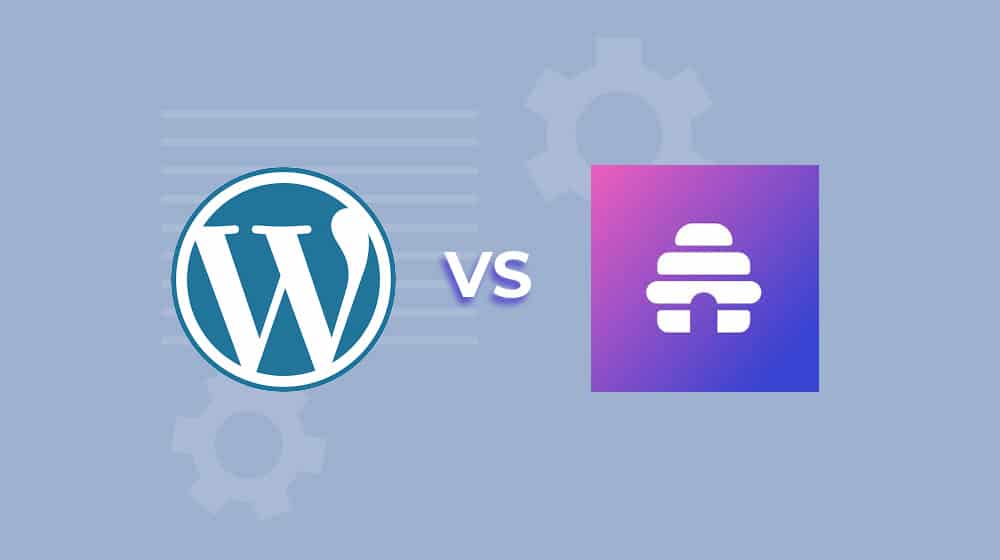
How do the two compare on specific aspects of running a website that might be relevant to you?
WordPress vs. Beehiiv: Pricing
Pricing is an obvious sticking point.
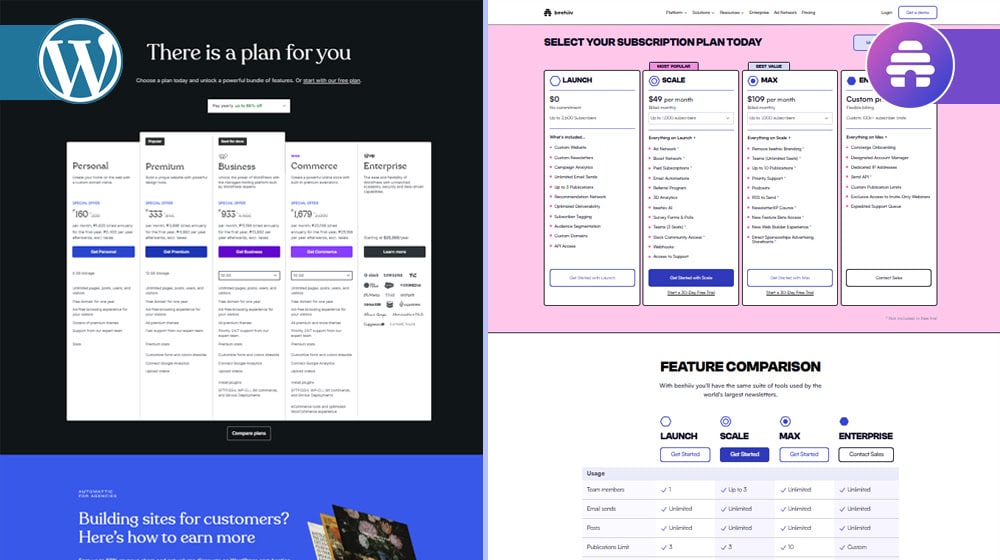
With WordPress, the simplest WordPress.com site is completely free and effectively unlimited, though you can only do so much with customization and plugin options.
With WordPress.org, you have the cost of a web host (somewhere around $15 per month), a domain name (another $15 per year), and the price of premium plugins you want to use (where the sky's the limit.)
You can make WordPress do just about everything Beehiiv can do, and a lot of the plugins to do it are free, though the better email management plugins tend to have steep pricing.
Beehiiv is very expensive if you're looking for white-label blog and newsletter management and you don't already have an established audience and income stream. The Launch version is good enough to get the ball rolling for free, though.
WordPress vs. Beehiiv: Custom Design
One of the biggest benefits of WordPress is that there are approximately 185 trillion WordPress themes out there, along with an equal number of plugins that can add features and change the appearance of the site, up to and including full page builder plugins. You can make your website look however you like, often with little or no coding, but you can also dig into the guts and code manually if you prefer.
Beehiiv is based entirely around a WYSIWYG, drag-and-drop, modular, template-based website builder. This is the same builder used for both the blogging side and the email side because it's effectively the same thing.
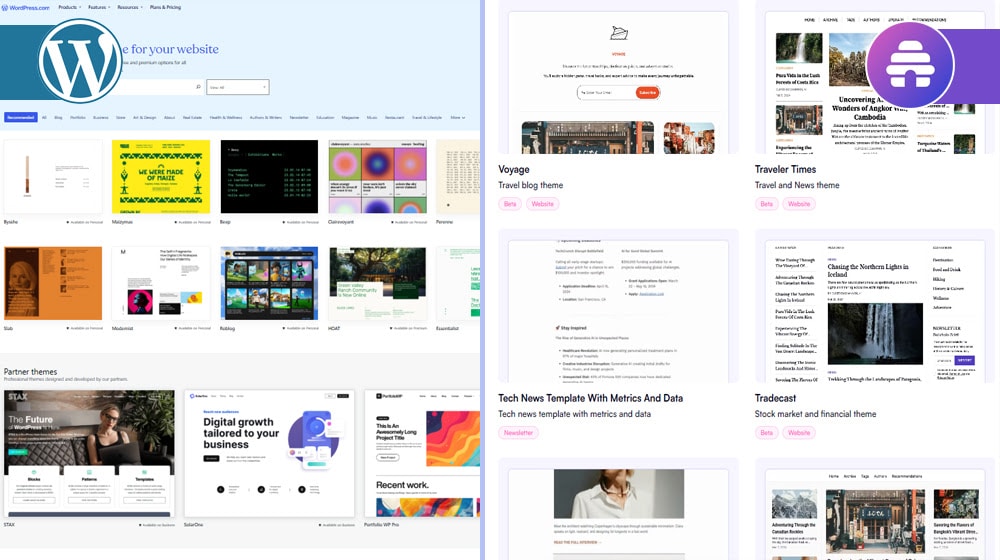
The tricky part is that the customization is relatively limited with Beehiiv. It's still fairly flexible, but it's nowhere near the full universe of customization that WordPress offers. That's not surprising, though; almost nothing short of another platform like Drupal or a completely custom website is.
WordPress can be overwhelming, but it doesn't have to be; since so much of it Just Works, all of the customization is very take-or-leave and can be adjusted later if need be.
WordPress vs. Beehiiv: Functionality
Again, Beehiiv has a few key features and functions going for it. The most important among them is the email management; they handle sending out emails, tracking email-related data, and managing subscriber lists. Running a blog is somewhat secondary to running a newsletter, though being realistic, it's not much of a burden because it's just publishing the newsletters publicly.
The other nice function of Beehiiv is the built-in monetization. Being able to natively hook up to a built-in ad network for display ads while still being able to use things like affiliate links and gate content for paid subscribers makes it all very powerful for monetization out of the box.
The downside here is that the monetization features are all gated behind paying for the plan, and it can definitely outweigh the income you get from your ads and subscribers for a long time until you grow enough to tip the scales.

WordPress does almost none of this out of the box, but as always, plugins let you do all of it and more. On top of that, there are many different options for those features, so you can pick the versions you like the most.
WordPress vs. Beehiiv: Rights and Ownership
One detail that can be relevant here is how your content is controlled.
Specifically, Beehiiv, since it's a platform hosting your content, has a lot of control over your site and your newsletter. If they decide you broke their ToS and ban you, your content, your site, and your subscribers all disappear. WordPress.com is like this, as are platforms like Substack, Medium, and Blogger, so it's not exactly unique. But it is worth considering.
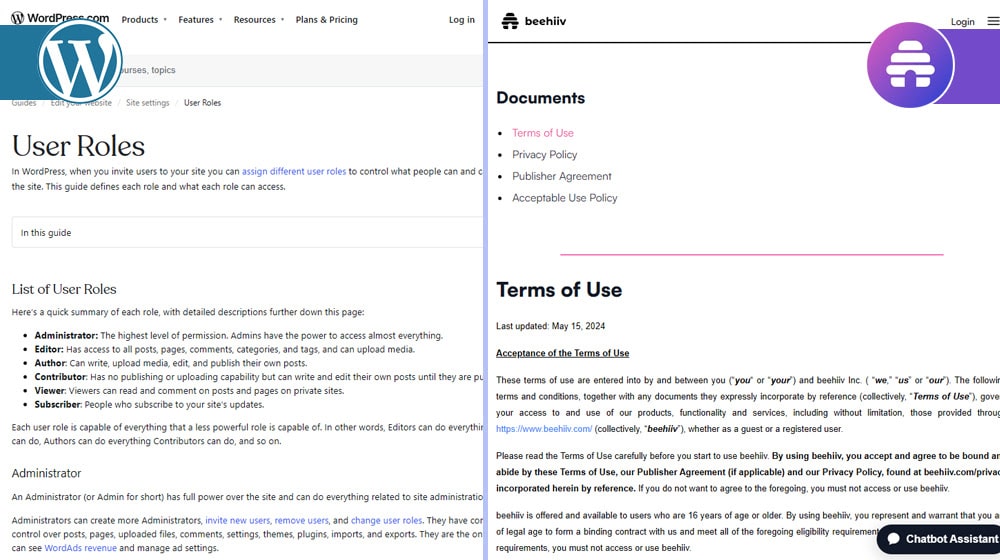
WordPress.org, being self-hosted, doesn't really have this problem. Oh, you're still beholden to your web host, but you can back up your site locally so you don't lose anything if you're shut down unexpectedly.
It's also worth mentioning that WordPress is run by an 11-year-old company with a long history of making relatively good decisions, adding features, and distinctly not making consumer-unfriendly choices. Conversely, Beehiiv is heavily backed by venture capital, has cranked up its pricing at least once already, and is likely under a lot of pressure to fall into the usual tech Infinite Growth Or Else paradigm that hurts so many other platforms in the long term.
WordPress vs. Beehiiv: SEO
Another major consideration for modern content marketing is SEO.
With WordPress, you have pretty much full control. You need plugins to make the most of it, but you can tweak and change every detail you can imagine.
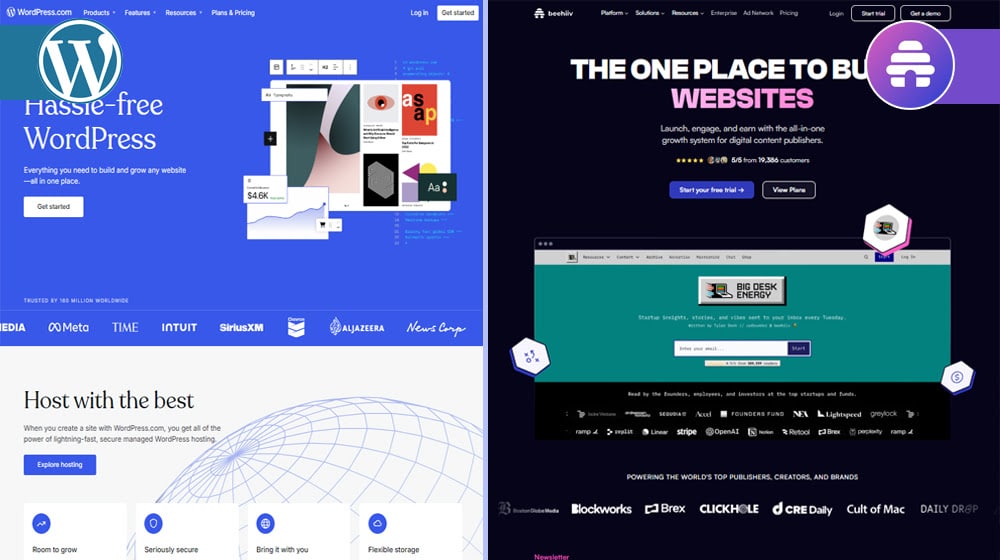
With Beehiiv, a lot of that is outside of your control. You can run a custom domain for the paid plans, and you can choose custom URLs, set metadata, and a lot of other basic SEO features. Others, though, you can't do anything with. You have no control over site speed optimizations, you can't use Schema, you can't implement redirects, and so on.
If you're just getting started and don't care about the last-mile optimizations, Beehiiv isn't going to feel bad. But, when you run into an edge case and really wish you could redirect that old post to a new one or make use of some Schema or another technique, it hurts.
WordPress and Beehiiv: Working Together
One thing to consider is that these two aren't necessarily competitors.
You can set up a WordPress blog and run it, and instead of using a plugin or other system to run a newsletter, you can run a newsletter through Beehiiv. The free plan is good enough when you're first rolling things out, and if you reach the point where you have 2,500 subscribers and you need to upgrade, you can. Or, Beehiiv makes it easy to export your subscribers list, so you can import it into a plugin integrated into your WordPress site and pick up where you left off.

You do lose out on things like white-label newsletters or the monetization options if you go this route since the free plan lacks those features, but it's still an effective basic option.
I still prefer WordPress. I've been deeply invested in the WordPress ecosystem for over a decade, and a lot of the reasons people balk at WordPress – like the complexity – aren't problems for me. But I'm curious: what do you think? Would you prefer to start a blog and newsletter on Beehiiv? Would you use the two together or partner one with a third system? Let me know!




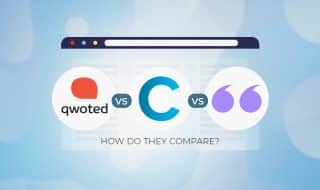





Comments